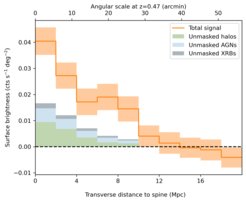Unveiling the 'Ghost' Baryonic Matter
A team of scientists from the Max Planck Institute for Extraterrestrial Physics has shed light on one of the most elusive components of the universe: the warm-hot intergalactic medium (WHIM). This "ghost" form of ordinary matter, long hypothesized but rarely detected, is thought to account for a significant portion of the universe's missing baryons — the matter that makes up stars, planets, and galaxies.

Led by Dr. Xiaoyuan Zhang, a postdoctoral fellow at the Max Planck Institute for Extraterrestrial Physics (MPE), the team of scientists revealed the existence of high-temperature, high-density regions of the WHIM by utilizing data from the eROSITA All-Sky Survey (eRASS). Over the course of two years, eROSITA, a powerful X-ray telescope aboard the Spektr-RG spacecraft, observed weak X-ray emission from the WHIM. To amplify these faint signals, the researchers employed a technique known as stacking, analyzing X-ray data at the locations of more than 7,000 cosmic filaments identified through the optical Sloan Digital Sky Survey (SDSS).
3D Filament Structures and eRASS Map
Due to its extremely low density (10 particles per cubic meter on average), the WHIM is notoriously difficult to observe. "Numerous studies have attempted to detect the WHIM using X-ray absorption, emission through X-rays, and the Sunyaev-Zeldovich effect. While some have yielded modestly positive results, they are often questioned due to potential contamination and systematic uncertainties. Now, with the eROSITA All-Sky Survey providing the deepest all-sky X-ray data, we have a unique opportunity to detect WHIM X-ray emission associated with large-scale cosmic structure." remarks Esra Bulbul, who is leading the clusters and cosmology group at the Max Planck Institute for Extraterrestrial Physics (MPE).
Tracing Cosmic Filaments
Cosmic filaments, the largest structures in the universe, form part of the intricate network of the cosmic web, which connects galaxies and galaxy clusters. Up to half of the matter in the Universe resides in filaments, which occupy less than 10% of its volume. Due to their anisotropic geometry and low density, filaments are difficult to detect in any of their components, such as gas or galaxies. “The most immediate way to achieve this is through the galaxy distribution. A breakthrough was accomplished when large-scale spectroscopic surveys such as SDSS became accessible and were coupled with complex algorithms to detect the filaments. This is the approach that we followed, which allowed us to trace the position of filaments to then allow for their stacking analysis.” says Dr. Nicola Malavasi, a Marie Skłodowska-Curie fellow at MPE, who performed the filament finding. Within these filaments resides the WHIM, a diffuse gas that emits only weak X-rays, making it nearly impossible to detect directly. However, the team’s sophisticated stacking method has allowed for a clearer picture of this emission, revealing the presence of WHIM and a measurement of its average temperature and density. This discovery brings scientists closer to resolving the long-standing puzzle of the universe's missing baryons and offers new insights into the structure and evolution of the cosmic web.

“Surprisingly, we had a strong X-ray detection (9σ) of the cosmic web. This was not the end of the story. We also needed to carefully model the contamination from the undetected galactic sources, which was the key to disclosing how much of our signal is from the WHIM.” said Xiaoyuan Zhang, the study's leading author. The study introduces an innovative method for estimating contamination from unmasked X-ray halos, active galactic nuclei, and X-ray binaries associated with filament galaxies. The analysis revealed an approximate 40% contamination fraction, indicating that around 60% of the detected signal may originate from the WHIM, with a detection significance of 5.4σ.
The team looked deeper into the properties of the recently detected WHIM, which allows them to gather critical insights into its nature. Their findings of the state-of-the-art numerical simulation indicate that the observed X-ray signal likely originates from WHIM regions with temperatures in the range of several million Kelvin and densities of approximately 100 particles per cubic meter.
Next-Generation Galaxy Surveys
Dr. Zhang adds, “Our new results demonstrate the immense potential of eROSITA’s survey data in detecting extremely faint diffuse cosmic plasmas.” Their work not only confirms the existence of the elusive WHIM but also opens new avenues for studying the role of these ghostly baryons in shaping the universe’s large-scale structure. This discovery marks a significant step forward in understanding the universe’s composition and the hidden ordinary matter that weaves the vast cosmic web together.
Andrea Merloni, Principal Investigator of the eROSITA project at MPE, ventures a look into the future: “Over the next few years, new large-scale spectroscopic galaxy surveys such as DESI and 4MOST will provide larger, more detailed galaxy and filament maps. The much larger overlap of these surveys with the eROSITA all-sky data will ensure a more refined analysis of the stacked X-ray data and bring to light new pieces of information on the WHIM physical state”.
This project has received funding from the European Research Council (ERC) under the European Union’s Horizon 2020 research and innovation programme (grant agreement No 101002585)













